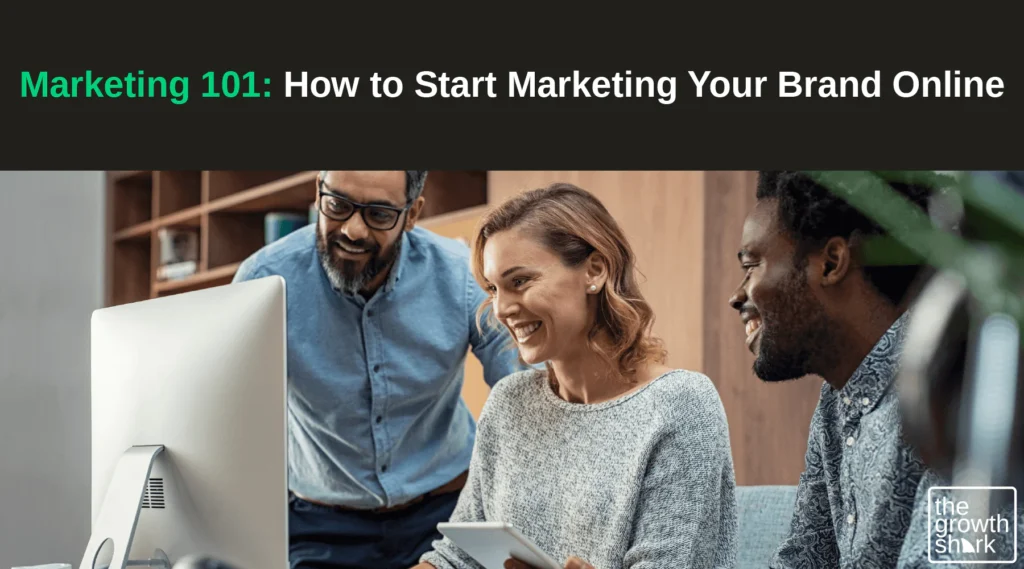The possibilities are endless when it comes to advertising your brand online.
So how can you maximize your marketing plan to return the best conversion rates?
Where do you find leads, and how do you tap into the areas where your consumers spend the most time?
Let’s look and learn how to get your brand out there with digital marketing fundamentals.
Basic Marketing Concepts: Your Marketing 101 Crash Course
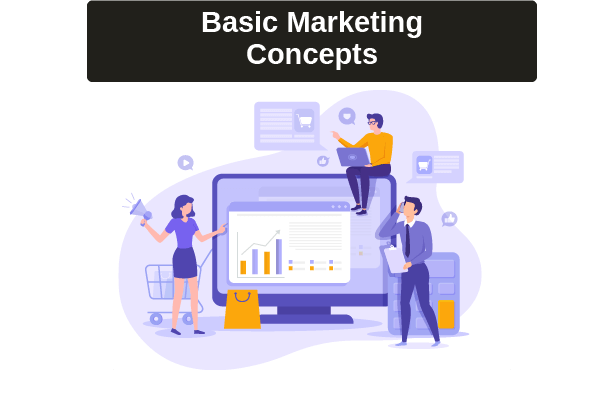
Before we dive into digital marketing, a few marketing basics are worth discussing.
Marketing fundamentals span across all formats, including digital marketing.
What Are the Basics of Marketing?
Marketing is actively promoting and selling your product or service.
This includes advertising and market research to reach the biggest portion of your target demographic.
Find the most budget-friendly ways to reach the widest audiences through digital marketing.
The Golden Rule of Marketing
The golden rule of marketing is learning what your audience wants and finding a way to deliver that to them.
You can learn about your potential customers through specific data points that will give you the information you need to pivot your strategy.
With digital marketing, the data markers are endless, including how long a person stays on your website, how far they scroll down, and when they exit the page.
These marketing metrics will make all the difference in measuring the success of your marketing strategy.
What Is Digital Marketing?
Digital marketing encompasses all the ways you spread awareness of your brand online.
Digital marketing includes social media marketing, search engine optimization, paid ads, email marketing, and more.
The 4 Ps of Marketing

Marketing fundamentals can begin with the four Ps: product, price, place, and promotion.
Investopedia explains, “The four Ps are often referred to as the marketing mix. They encompass a range of factors that are considered when marketing a product, including what consumers want, how the product or service meets or fails to meet those wants, how the product or service is perceived in the world, how it stands out from the competition, and how the company that produces it interacts with its customers.
Since the four Ps were introduced in the 1950s, more Ps have been identified, including people, process, and physical evidence.”
Depending on your marketing plan, the 4 Ps expand to more specific areas of focus. But it’s certainly convenient to have a starting point.
Understand the Basics of Marketing Strategy
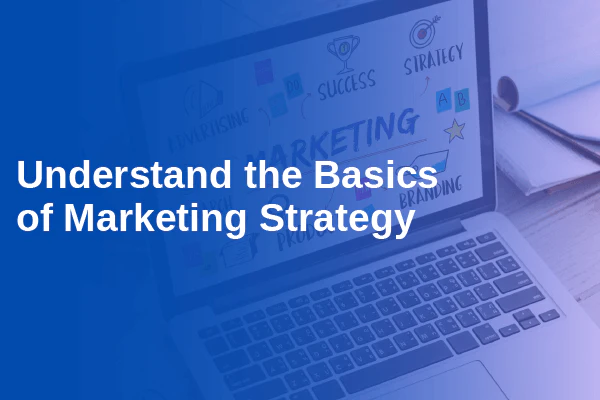
Marketing fundamentals include creating a digital marketing strategy that will detail your plan of execution.
When you’ve created a comprehensive marketing plan, you can refer back to the plan as you’ve gathered data to support changes to the original strategy.
What worked? And what didn’t work? These two questions are essential to digital marketing fundamentals.
What Is Meant by Marketing Strategy?
A marketing strategy starts with focusing on the four Ps.
Is the product the best it can be in solving a problem for the consumer?
Have you honed in on the correct price to be competitive while turning a strong profit?
Where are you going to sell your product? A place can be representative of demographics, digital formats, or whether you sell the product in person.
Promotion is about advertising and blasting your brand to the broadest audience possible.
How Do You Create a Marketing Strategy?
Create a marketing strategy before you take any action in spreading the word about your product.
- Set realistic goals.
- Conduct market research to learn about competitors, your target audience, and a realistic budget for meeting your goal.
- Brainstorm possible marketing techniques.
- Define your budget.
- Get started by implementing multiple advertising tactics and tweaking the plan as you collect data.
Executing the plan requires a huge leap of faith in many cases. But when you are open to changing the plan as data comes in, you will not waste too much time along the way.
Here’s What Makes a Good Marketing Plan
A good marketing plan should be clear, executable, and trackable.
Going in with a plan is just as important as knowing when to throw in the towel and pivot.
Marketing Strategy Examples
Which aspects of marketing fundamentals should you include in your strategy? Here are some ideas:
Calls to Action (CTAs): Make sure the consumer always knows where to find your website and product.
At the end of every communication, embed a link to your landing page where they can find more information.
A landing page is the first impression consumers see when redirected to your website. Make it count by making an intentional, engaging, and informative landing page.
Giveaways: People like free stuff.
Whether you give away a new product with a purchase or unlock free shipping at a certain spending threshold, consumers love a free gift.
Introduce free gifts to promote product awareness. If you have a new product you want consumers to fall in love with, include a sample as a free gift.
Check out more examples from Indeed: “Businesses create marketing strategies to better communicate awareness of their product or service to consumers. Developing a marketing strategy allows a company to streamline product development and create clear objectives.
Companies can then guide their campaigns in a forward-thinking direction that will attract consumers most likely to purchase their products or services.”
What Is a Digital Marketing Strategy and Plan?
Digital marketing fundamentals include creating a strategy that will reach the most consumers.
In the business-to-consumer (B2C) world, digital marketing is the most common strategy to take in order to reach the widest audience.
Take into account how many hours the average consumer spends online daily.
Why not tap into the areas of the internet where people are most likely to see your brand?
Let’s discuss the types of digital marketing and how they can benefit your business.
Remember The Most Important Things in Digital Marketing
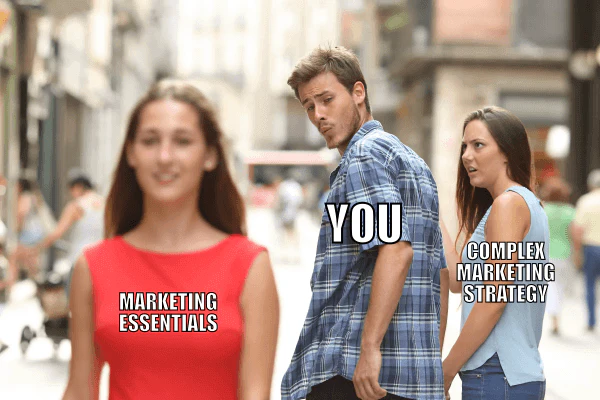
Digital marketing efforts center around these areas: lead generation, lead capturing, lead nurturing, and lead conversion.
A lead is someone who shows interest in your product.
You may find out about their interest when they visit your website, click on a CTA prompt, or fill out a form on your website.
A lead doesn’t always convert to a sale, which is why your digital marketing efforts should guide the lead toward finding out more about your product until they are ready to buy.
What Is Online Lead Generation?
Online lead generation is the process of finding out about leads through any form of online communication.
This can include email marketing, social media interest, paid ads, or links from other websites.
How Do You Capture Leads Online?
Paid ads are common ways to get your brand out there and increase brand awareness.
Someone may choose to follow your page after seeing an ad on Instagram or Facebook.
Or they can sign up for emails when they find out about your product, hoping to learn about future sales and promotions.
Any initial action is a good one because you are halfway there to sealing the deal when you know someone is interested enough to spend time on your brand.
Lead Nurturing in Digital Marketing
A lot of people learn about a brand and get exposure before they move toward buying the product.
Nurturing your lead is important because you can continually provide positive interactions with your brand, leaving a lasting impression.
“Lead nurturing is when businesses build relationships with prospects. It is an important aspect of inbound marketing, which is the use of content marketing, social media and other online communications methods to attract customers’ attention.
When a potential customer finds your business, they may not be ready to purchase your products or services. Nurturing leads is an effective strategy for driving sales, because it can keep you top of mind for prospects so they come back when they are ready to purchase.” – Business News Daily
Email marketing or social media posts are great ways to keep your leads in the know until they are ready to make their purchase.
The Growth Shark knows all about nurturing leads and converting them into sales. Work with our team to build a strategy specific to your company.
Lead Conversion and Good Conversion Rates
Lead conversions are when the lead finally converts into a sale for the company.
Sales are the main reason for marketing fundamentals. They are the end game.
When a lead converts into a sale, it is considered the ultimate success in all types of digital marketing.
A good conversion rate would be 20% of your leads converting into sales for your company.
And even better, if you have a high customer return rate, those existing customers will become recurring customers.
This brand loyalty is another solid goal of digital marketing fundamentals.
Explore Different Types of Digital Marketing

Let’s talk about some of the most popular and successful types of digital marketing.
How can you get your brand name out there to the most potential customers at the lowest possible cost?
SEO Marketing to Get Your Website Found on Google
Search engine optimization is a great way to find leads.
A customer may search “hair salon near me,” and if your website is optimized for a Google search, your company will come up near the top of the list.
This type of organic lead generation is powerful, but it takes time and expertise to build your website’s SEO success.
Paid Advertising to Increase Brand or Product Exposure
Think about ads that pop up as you scroll through Instagram or the sponsored links at the top of a Google search.
A company pays for those ads to pop up and expose consumers to its brand.
Paid ads or pay-per-click advertising is a great way to get your foot in the door and gain recognition for your brand.
If you can get a significant conversion rate from paid ads, then spending a little of your marketing budget on paid advertising is well worth it.
Find the sweet spot that includes a reasonable paid ads budget and a high conversion rate for your paid ads. Then you can make sure your investment isn’t in vain.
Social Media Marketing to Build Your Brand
Build your social media page in order to spread brand awareness. If you have thousands of followers, those leads will see your content daily.
Social media marketing is organic but requires effort from the company.
Invest your efforts toward a consistent social media campaign to get the best conversion rate on social media leads.
This should include posting daily or at least a few times per week to keep your followers engaged and interested in what you have to offer.
“Each social media platform has a demographic that comprises most of its users. For example, professionals and B2B businesses tend to congregate on LinkedIn, while TikTok and Snapchat users tend to be Gen Z and young millennials. Unless you’re targeting everyone, you don’t need to establish a social media presence on all available platforms.” – Business.com
Be strategic about which platforms you utilize for your brand. Do not forget to get personal and tell your story in order to connect with your followers.
Content Marketing to Build Trust With Your Market
Content marketing fits into many of these types of digital marketing.
Your high-quality content can be showcased through a blog, social media posts, email marketing, and more. Use SEO keywords to increase leads.
Creative and unique content is essential to building a solid SEO strategy and converting leads from social media marketing.
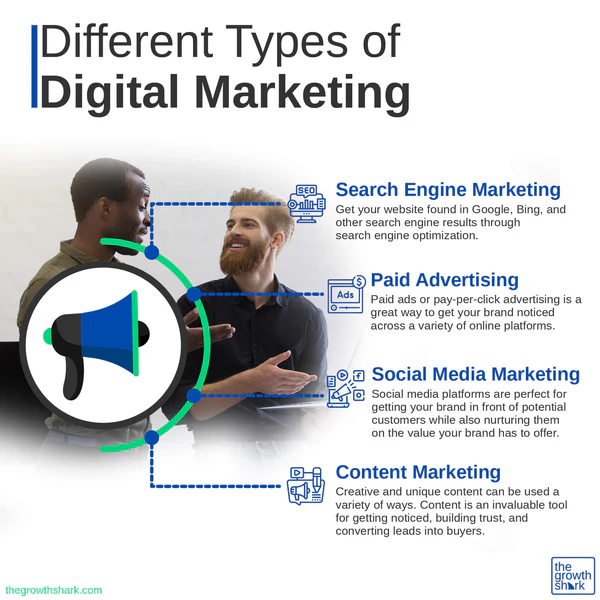
Get Your Business Started on Digital Marketing Today
It can feel overwhelming to get started with marketing fundamentals. If you had trouble understanding any of the marketing terms we covered, be sure to check out this glossary of digital marketing terms.
Or perhaps you know all about marketing basics but have trouble diving into the digital marketing formats.
Our team is here to help. We can set up a call and answer any questions you may have before building your digital marketing strategy.
And if you found this guide helpful, be sure to check out this article, on How to Use SEO to Reach Page #1 of Google.


